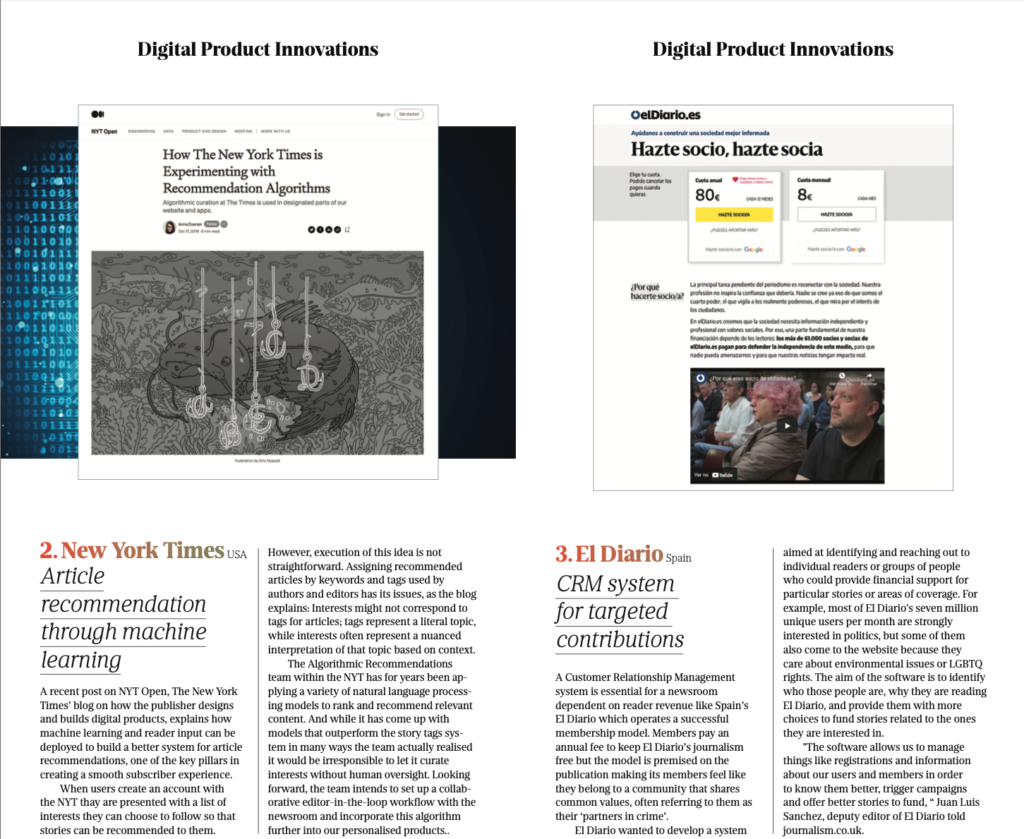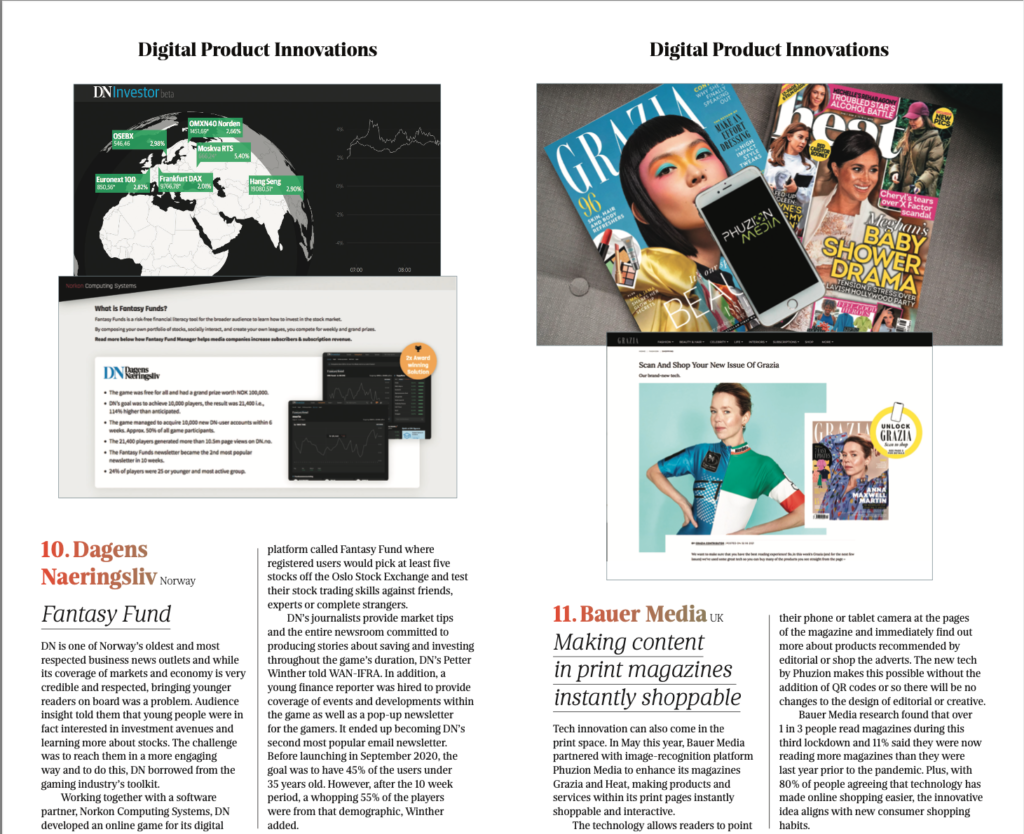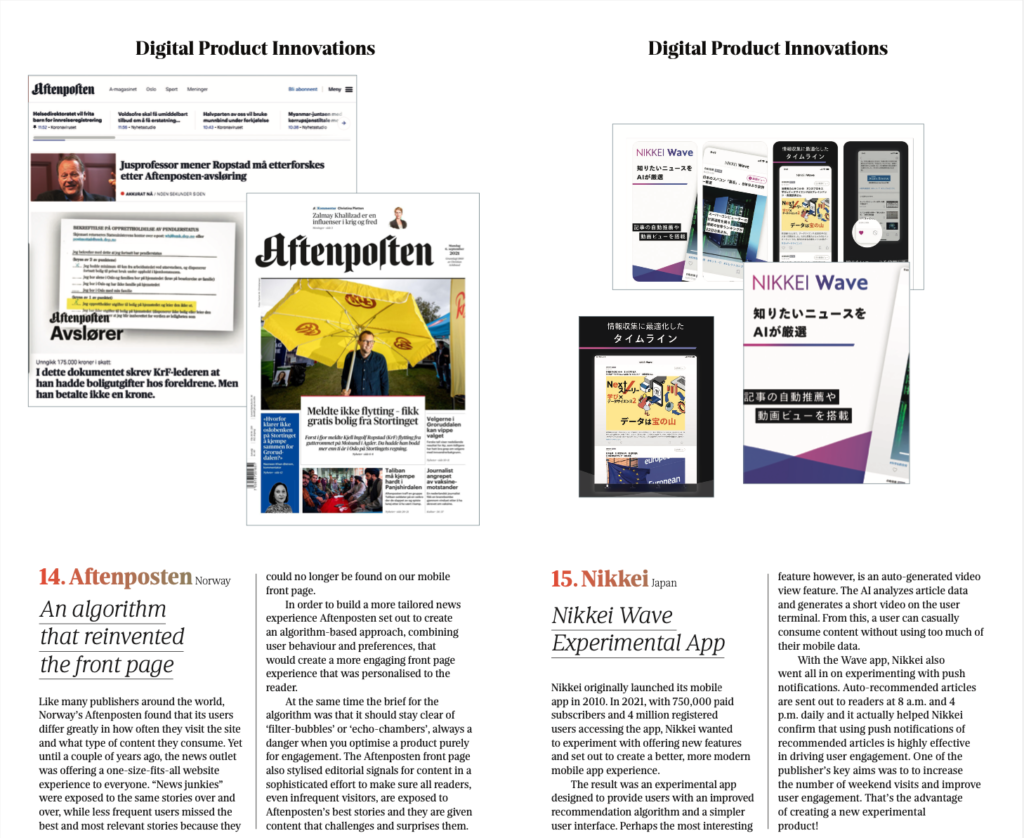
04 Jul 15 Best Digital Product Innovations
What are the most interesting ways in which publishers are using technology to drive innovation? Building an effective reader revenue strategy, key to building a sustainable future for news media, increasingly involves collaboration across various teams – from editorial, product, data science and marketing. The effective use of technology can tie all the efforts and learnings of these teams together to create the best user experiences and subscriber retention strategies. Luckily some of the best documentation on experimental news products come through blogs run by publishers like The Guardian, The New York Times and the BBC who are eager to share case studies. Here’s what we can learn from them, and others.

1.BBC (UK) Graphical story editor
The BBC has conducted various experiments in using automation to convert old stories into new formats or using technology to enhance existing articles. A great example is a graphical story editor, developed by the BBC News Labs and debuted in October 2020, that allows stories to be converted into a completely new, digestible format for audiences on Instagram and Facebook. “BBC News is now the most popular news account on Instagram with over 15m followers. Our audience on the social platform is predominantly under 25. We wanted to see if we could reach this audience with content that isn’t jarring within their social feed whilst also fulfilling the BBC’s remit of informing and educating everyone,” the News Labs team explains in an article.
Creating such content can be time consuming if one were to ask journalists to reword their stories and work on graphics. The tool developed by the BBC has a catalogue of images and pre-set templates. When text is fed in, such as the BBCs reporting on Covid-19, it successfully detects quotes and percentages in stories and renders different types of smartphone screen-sized panels. “It was important that crafting these stories felt magical, with journalists’ words turning into meaningful graphics without any extra work on their part,” the team adds. Still a prototype, the BBC is thinking about integrating the tool into their CMS.
2.New York Times (USA) Article recommendation through machine learning
A recent post on NYT Open, The New York Times’ blog on how the publisher designs and builds digital products, explains how machine learning and reader input can be deployed to build a better system for article recommendations, one of the key pillars in creating a smooth subscriber experience. When users create an account with the NYT thay are presented with a list of interests they can choose to follow so that stories can be recommended to them. However, execution of this idea is not straightforward. Assigning recommended articles by keywords and tags used by authors and editors has its issues, as the blog explains: Interests might not correspond to tags for articles; tags represent a literal topic, while interests often represent a nuanced interpretation of that topic based on context.
The Algorithmic Recommendations team within the NYT has for years been applying a variety of natural language processing models to rank and recommend relevant content. And while it has come up with models that outperform the story tags system in many ways the team actually realised it would be irresponsible to let it curate interests without human oversight. Looking forward, the team intends to set up a collaborative editor-in-the-loop workflow with the newsroom and incorporate this algorithm further into our personalised products.
3.El Diario (Spain) CRM system for targeted contributions
A Customer Relationship Management system is essential for a newsroom dependent on reader revenue like Spain’s El Diario which operates a successful membership model. Members pay an annual fee to keep El Diario’s journalism free but the model is premised on the publication making its members feel like they belong to a community that shares common values, often referring to them as their ‘partners in crime’. El Diario wanted to develop a system aimed at identifying and reaching out to individual readers or groups of people who could provide financial support for particular stories or areas of coverage.
For example, most of El Diario’s seven million unique users per month are strongly interested in politics, but some of them also come to the website because they care about environmental issues or LGBTQ rights. The aim of the software is to identify who those people are, why they are reading El Diario, and provide them with more choices to fund stories related to the ones they are interested in. “The software allows us to manage things like registrations and information about our users and members in order to know them better, trigger campaigns and offer better stories to fund, “ Juan Luis Sanchez, deputy editor of El Diario told journalism.co.uk.
4.The Guardian (UK) Typerighter In November 2020
The Guardian introduced Typerighter, a tool that takes information from the paper’s style guide and flags to journalists when they use terms incorrectly. In Inside the Guardian, a blog the newspaper publishes on changes and updates to its digital publishing, The Guardian explained that over time, its famous style guide has grown bigger and more complex. It contains more and more nuanced guidelines on issues – immigration, gender and many others – that need to be corrected and checked. Typerighter has been built into the Guardian’s existing inhouse editing software – Composer. The blog explains that it acts as an aid to journalists and sub-editors, quietly helping out in the background, but never getting in the way of focusing on maintaining the quality of the writing. “As for sub-editors, we have more time for the other aspects of our job – the headlines, pictures and compelling standfirsts,” it adds.
5.Agderposten (Norway) Fully automated print layout
Agderposten is a Norwegian newspaper that publishes 30 to 60 pages daily depending on the day. They were using two different CMS platforms, one for print and one to convert their print content to digital. Reporters had to work on the same story in 2 different places and its editors spent a great deal of effort to lay down the newspaper each evening. The company wanted to look for a solution — was there a way to produce pages that looked and felt like they had been created by experienced designers and editors — but were actually built by automation? Agderposten opted for a content management system called Naviga Publisher, powered by the Sophi.io AI technology developed by Canada’s The Globe and Mail.
Using the new CMS, Agderposten’s editors selected the content they wanted to print, prioritised it, and could also specify how much of the page they’d like to devote to a particular article. Sophi then ran all the AI work behind the scenes to create the print-ready newspaper. This was done without the use of templates, maintaining the look and feel of the newspaper. “Agderposten’s editors could hit the print button and be done, or alter the paper as news broke, then rerun the automated process within a minute,” writes Sonali Verma, Senior Product Manager for The Globe and Mail, in a post for INMA.

6.Frankfurter Allgemeine Zeitung (Germany) F.A.Z. Personal Assistant
The German publisher wanted to create a product that had the feeling of a personalised service. F.A.Z. Assistant, available only to subscribers as a product extension on the publishers website and mobile app, provides a slick version of this experience, promising to bring order rather than pelt the user with multiple news inputs. The product offers a variety of assistant services. Algorithm-based push briefings deliver the most relevant content directly on lockscreen, tailored for every user individually. A personalised email newsletter is delivered to the user using AI to curate the right articles and to investigate the right time to send the email to the receiver. The Assistant also offers a personalised news stream and a curated text-to-speech playlist of articles for times that users want to be updated but don’t have time to read. Since the F.A.Z. Assistant was introduced in 2020 the publisher says subscriber engagement — visits per subscriber to the site — has increased 46% per month over the previous year.
7.Wall Street Journal (USA) Project Boomerang
The pandemic brought a record number of readers to The Wall Street Journal and digital subscriptions also hit an all-time high. Like many publishers the Journal wanted to capitalise on this wave and get new and less-engaged members (who visit WSJ fewer than 10 days per month) to come back more often as that would improve subscriber retention. The Journal’s digital experience and strategy team got to work on Project Boomerang, mapping out different ways in which digital products could be presented in order to sustain interest and build durable habits.
The team introduced a daily email offering a convenient link to the PDF version of the WSJ’s print edition since the pandemic had cut into retail sales and home delivery. Smaller changes also drove tangible results: A new “Podcasts” link drove a 16% increase in podcast plays in its first month and “related newsletter” promotions on stories invited mobile search audiences to sample more of the Journal’s reporting. Another big success was the introduction of the ‘Listen to this article’ feature which provides an automatically generated, text-to-speech audio version of every story on WSJ.com, which proved to be more habit-forming than their popular crossword puzzle.
8.Bergens Tidende (Norway) Automation to write real estate stories
Local stories about the real estate market are relatable for most readers but churning them out is incredibly time-consuming. Mapping neighbourhoods, properties and sales, especially in large towns, is a mammoth task which is why Norway’s regional title Bergens Tidende experimented in 2019 with the ‘Boligrobot’, a piece of tech that creates automated text about the real estate market. The Boligrobot finds information about the real estate, like current prices, addresses, areas, changes in prices over time, the price of a square meter, and so on. This data comes from agencies and is gathered by the Norwegian authorities. Then, it finds great aerial and panorama photos from a supplier, supplemented by images from Google street view.
These pictures are particularly valuable to readers. One of the main reasons to work with a robot was to engage more readers and sell more subscriptions. “Since launching in mid-July 2020, we have sold 500 subscriptions from nearly 6000 automated articles. We anticipate roughly 1000 new subscriptions per year. That’s five percent of all the article conversions in BT, overnight establishing the robot as the most popular service to our readers,” the publication reported in 2021.
9.Financial Times (UK) Borrowing the Instagram story bubbles format
The FT’s product and technology team spotted a unique opportunity for growth during the pandemic as people were looking to create new habits. One task identified was to increase engagement with MyFT, a feature within the FT App which enables readers to select topics of interest to follow, thus creating an onsite feed which is customised to their specific needs. The team took inspiration from social media. MyFT started using Instagram style story bubbles which moved to the far left to indicate where the most recent articles were published. The use of images and red dots also provided quick visual cues as to a change on the page or new articles waiting to be read. “Our hunch was that by providing a more dynamic experience which was easily navigable, modern, topic and image led, users would interact with myFT more frequently,” writes Anna Lisinski, a product manager for the FT, in a blog post, adding that a dynamic experience is important in habit formation as it creates the feeling of change. If nothing changes on a return visit, what is the benefit of returning? Initial testing showed that visit frequency to the App increased by almost 40%.
10.Dagens Naeringsliv (Norway) Fantasy Fund
DN is one of Norway’s oldest and most respected business news outlets and while its coverage of markets and economy is very credible and respected, bringing younger readers on board was a problem. Audience insight told them that young people were in fact interested in investment avenues and learning more about stocks. The challenge was to reach them in a more engaging way and to do this, DN borrowed from the gaming industry’s toolkit. Working together with a software partner, Norkon Computing Systems, DN developed an online game for its digital platform called Fantasy Fund where registered users would pick at least five stocks off the Oslo Stock Exchange and test their stock trading skills against friends, experts or complete strangers.
DN’s journalists provide market tips and the entire newsroom committed to producing stories about saving and investing throughout the game’s duration, DN’s Petter Winther told WAN-IFRA. In addition, a young finance reporter was hired to provide coverage of events and developments within the game as well as a pop-up newsletter for the gamers. It ended up becoming DN’s second most popular email newsletter. Before launching in September 2020, the goal was to have 45% of the users under 35 years old. However, after the 10 week period, a whopping 55% of the players were from that demographic, Winther added.

11.Bauer Media (UK) Making content in print magazines instantly shoppable
Tech innovation can also come in the print space. In May this year, Bauer Media partnered with image-recognition platform Phuzion Media to enhance its magazines Grazia and Heat, making products and services within its print pages instantly shoppable and interactive. The technology allows readers to point their phone or tablet camera at the pages of the magazine and immediately find out more about products recommended by editorial or shop the adverts. The new tech by Phuzion makes this possible without the addition of QR codes or so there will be no changes to the design of editorial or creative. Bauer Media research found that over 1 in 3 people read magazines during this third lockdown and 11% said they were now reading more magazines than they were last year prior to the pandemic. Plus, with 80% of people agreeing that technology has made online shopping easier, the innovative idea aligns with new consumer shopping habits.
12.Kronen Zeitung (Austria) AI to moderate user comments
Journalists at Kronen Zeitung, one of Austria’s largest news publishers, see that the audience is very much part of the newsroom. Readers post some 500k comments on the website each month – on top of the discussions on social media – and reporters are pushed toward stories that matter to the community. However, half a million comments a month is way too much for a team of human moderators to sift through especially with spam, abuse and other kinds of online hatred thrown in. And so began the experiment with artificial intelligence-powered tools that were brought into the newsroom to help clean up the comment section to make readers feel safe and moderators’ jobs less stressful. The team at Kronen Zeitung experimented with a couple of softwares before settling on a Finnish company called Utopia Analytics. Today, it filters about three quarters of all comments, flagging up words or expressions that may go against community guidelines. This is a huge timesaver for human moderators who can work on publishing the comments in real time. To the publisher’s surprise, this increased engagement by around 25%.
13.Times and Sunday Times (UK) Tailored emails from ‘James’
A “digital butler” known as James (Journey Automated Messaging for Higher Engagement) creates individualised emails for Time and Sunday Times subscribers by predicting content they are likely to be interested in, and then sending it in their preferred format at the time they are most likely to read it. The company carried out a nine-month trial of the new AI technology in 2018 after receiving funding from Google’s Digital News Initiative and collaborating software company Twipe.
According to Press Gazette, the trial revealed that 70% of 117,000 randomly chosen subscribers interacted with James by either opening or clicking on the newsletter. The technology was most effective with the least-engaged Times subscribers, with highly loyal readers more likely to already be happy with how they receive their content. “James created habits among the lowest engaged groups which are the hardest groups for us to retain,” Mike Migliore, head of customer value at News UK, was quoted as saying. James had been used for emails, but the publisher plans to expand the service to channels like text messaging and push notifications in future and could also be used to better personalise targeted advertising.
14.Aftenposten (Norway) An algorithm that reinvented the front page
Like many publishers around the world, Norway’s Aftenposten found that its users differ greatly in how often they visit the site and what type of content they consume. Yet until a couple of years ago, the news outlet was offering a one-size-fits-all website experience to everyone. “News junkies” were exposed to the same stories over and over, while less frequent users missed the best and most relevant stories because they could no longer be found on our mobile front page. In order to build a more tailored news experience Aftenposten set out to create an algorithm-based approach, combining user behaviour and preferences, that would create a more engaging front page experience that was personalised to the reader.
At the same time the brief for the algorithm was that it should stay clear of ‘filter-bubbles’ or ‘echo-chambers’, always a danger when you optimise a product purely for engagement. The Aftenposten front page also stylised editorial signals for content in a sophisticated effort to make sure all readers, even infrequent visitors, are exposed to Aftenposten’s best stories and they are given content that challenges and surprises them.
15.Nikkei (Japan) Nikkei Wave Experimental App
Nikkei originally launched its mobile app in 2010. In 2021, with 750,000 paid subscribers and 4 million registered users accessing the app, Nikkei wanted to experiment with offering new features and set out to create a better, more modern mobile app experience. The result was an experimental app designed to provide users with an improved recommendation algorithm and a simpler user interface. Perhaps the most interesting feature however, is an auto-generated video view feature. The AI analyzes article data and generates a short video on the user terminal.
From this, a user can casually consume content without using too much of their mobile data. With the Wave app, Nikkei also went all in on experimenting with push notifications. Auto-recommended articles are sent out to readers at 8 a.m. and 4 p.m. daily and it actually helped Nikkei confirm that using push notifications of recommended articles is highly effective in driving user engagement. One of the publisher’s key aims was to to increase the number of weekend visits and improve user engagement. That’s the advantage of creating a new experimental product!


